+ Open data
Open data
- Basic information
Basic information
| Entry | Database: PDB / ID: 6n2p | ||||||
|---|---|---|---|---|---|---|---|
| Title | Helical assembly of the CARD9 CARD | ||||||
 Components Components | Caspase recruitment domain-containing protein 9 | ||||||
 Keywords Keywords | SIGNALING PROTEIN / CARD / filament / helical assembly / death domain / innate immunity | ||||||
| Function / homology |  Function and homology information Function and homology informationregulation of interleukin-2 production / host-mediated modulation of intestinal microbiota composition / CBM complex / response to peptidoglycan / antifungal innate immune response / positive regulation of stress-activated MAPK cascade / CARD domain binding / positive regulation of T-helper 17 type immune response / response to aldosterone / neutrophil mediated immunity ...regulation of interleukin-2 production / host-mediated modulation of intestinal microbiota composition / CBM complex / response to peptidoglycan / antifungal innate immune response / positive regulation of stress-activated MAPK cascade / CARD domain binding / positive regulation of T-helper 17 type immune response / response to aldosterone / neutrophil mediated immunity / positive regulation of cytokine production involved in inflammatory response / positive regulation of innate immune response / positive regulation of granulocyte macrophage colony-stimulating factor production / positive regulation of macrophage cytokine production / response to exogenous dsRNA / response to muramyl dipeptide / positive regulation of interleukin-17 production / immunoglobulin mediated immune response / regulation of immune response / stress-activated MAPK cascade / positive regulation of chemokine production / JNK cascade / signaling adaptor activity / positive regulation of cytokine production / positive regulation of JNK cascade / apoptotic signaling pathway / positive regulation of NF-kappaB transcription factor activity / NOD1/2 Signaling Pathway / protein homooligomerization / positive regulation of interleukin-6 production / CLEC7A (Dectin-1) signaling / positive regulation of tumor necrosis factor production / regulation of apoptotic process / defense response to virus / positive regulation of ERK1 and ERK2 cascade / positive regulation of canonical NF-kappaB signal transduction / defense response to Gram-positive bacterium / response to xenobiotic stimulus / protein homodimerization activity / protein-containing complex / metal ion binding / identical protein binding / plasma membrane / cytoplasm / cytosol Similarity search - Function | ||||||
| Biological species |  Homo sapiens (human) Homo sapiens (human) | ||||||
| Method | ELECTRON MICROSCOPY / helical reconstruction / cryo EM / Resolution: 4 Å | ||||||
 Authors Authors | Holliday, M.J. / Rohou, A. / Arthur, C.P. / Dueber, E.C. / Fairbrother, W.J. | ||||||
 Citation Citation |  Journal: Nat Commun / Year: 2019 Journal: Nat Commun / Year: 2019Title: Structures of autoinhibited and polymerized forms of CARD9 reveal mechanisms of CARD9 and CARD11 activation. Authors: Michael J Holliday / Axel Witt / Alejandro Rodríguez Gama / Benjamin T Walters / Christopher P Arthur / Randal Halfmann / Alexis Rohou / Erin C Dueber / Wayne J Fairbrother /  Abstract: CARD9 and CARD11 drive immune cell activation by nucleating Bcl10 polymerization, but are held in an autoinhibited state prior to stimulation. Here, we elucidate the structural basis for this ...CARD9 and CARD11 drive immune cell activation by nucleating Bcl10 polymerization, but are held in an autoinhibited state prior to stimulation. Here, we elucidate the structural basis for this autoinhibition by determining the structure of a region of CARD9 that includes an extensive interface between its caspase recruitment domain (CARD) and coiled-coil domain. We demonstrate, for both CARD9 and CARD11, that disruption of this interface leads to hyperactivation in cells and to the formation of Bcl10-templating filaments in vitro, illuminating the mechanism of action of numerous oncogenic mutations of CARD11. These structural insights enable us to characterize two similar, yet distinct, mechanisms by which autoinhibition is relieved in the course of canonical CARD9 or CARD11 activation. We also dissect the molecular determinants of helical template assembly by solving the structure of the CARD9 filament. Taken together, these findings delineate the structural mechanisms of inhibition and activation within this protein family. | ||||||
| History |
|
- Structure visualization
Structure visualization
| Movie |
 Movie viewer Movie viewer |
|---|---|
| Structure viewer | Molecule:  Molmil Molmil Jmol/JSmol Jmol/JSmol |
- Downloads & links
Downloads & links
- Download
Download
| PDBx/mmCIF format |  6n2p.cif.gz 6n2p.cif.gz | 305.8 KB | Display |  PDBx/mmCIF format PDBx/mmCIF format |
|---|---|---|---|---|
| PDB format |  pdb6n2p.ent.gz pdb6n2p.ent.gz | 252 KB | Display |  PDB format PDB format |
| PDBx/mmJSON format |  6n2p.json.gz 6n2p.json.gz | Tree view |  PDBx/mmJSON format PDBx/mmJSON format | |
| Others |  Other downloads Other downloads |
-Validation report
| Summary document |  6n2p_validation.pdf.gz 6n2p_validation.pdf.gz | 924.5 KB | Display |  wwPDB validaton report wwPDB validaton report |
|---|---|---|---|---|
| Full document |  6n2p_full_validation.pdf.gz 6n2p_full_validation.pdf.gz | 931.4 KB | Display | |
| Data in XML |  6n2p_validation.xml.gz 6n2p_validation.xml.gz | 29.3 KB | Display | |
| Data in CIF |  6n2p_validation.cif.gz 6n2p_validation.cif.gz | 45.3 KB | Display | |
| Arichive directory |  https://data.pdbj.org/pub/pdb/validation_reports/n2/6n2p https://data.pdbj.org/pub/pdb/validation_reports/n2/6n2p ftp://data.pdbj.org/pub/pdb/validation_reports/n2/6n2p ftp://data.pdbj.org/pub/pdb/validation_reports/n2/6n2p | HTTPS FTP |
-Related structure data
| Related structure data |  9332MC  6n2mC C: citing same article ( M: map data used to model this data |
|---|---|
| Similar structure data |
- Links
Links
- Assembly
Assembly
| Deposited unit | 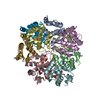
|
|---|---|
| 1 |
|
| Symmetry | Helical symmetry: (Circular symmetry: 1 / Dyad axis: no / N subunits divisor: 1 / Num. of operations: 10 / Rise per n subunits: 5.11 Å / Rotation per n subunits: -101.6 °) |
- Components
Components
| #1: Protein | Mass: 17351.873 Da / Num. of mol.: 10 / Mutation: I107E Source method: isolated from a genetically manipulated source Source: (gene. exp.)  Homo sapiens (human) / Gene: CARD9 / Production host: Homo sapiens (human) / Gene: CARD9 / Production host:  |
|---|
-Experimental details
-Experiment
| Experiment | Method: ELECTRON MICROSCOPY |
|---|---|
| EM experiment | Aggregation state: FILAMENT / 3D reconstruction method: helical reconstruction |
- Sample preparation
Sample preparation
| Component | Name: Helical assembly of the CARD9 CARD. / Type: COMPLEX Details: Formed from CARD9 2-152 dimer with an I107E mutation, purified with 1:1 Zn. 1 mM EDTA was added to 0.5 mM protein, followed by 10 minute incubation at 25C. Entity ID: all / Source: RECOMBINANT | ||||||||||||||||||||||||||||||
|---|---|---|---|---|---|---|---|---|---|---|---|---|---|---|---|---|---|---|---|---|---|---|---|---|---|---|---|---|---|---|---|
| Molecular weight | Value: 34.0 kDa/nm / Experimental value: YES | ||||||||||||||||||||||||||||||
| Source (natural) | Organism:  Homo sapiens (human) Homo sapiens (human) | ||||||||||||||||||||||||||||||
| Source (recombinant) | Organism:  | ||||||||||||||||||||||||||||||
| Buffer solution | pH: 7 | ||||||||||||||||||||||||||||||
| Buffer component |
| ||||||||||||||||||||||||||||||
| Specimen | Conc.: 8.67 mg/ml / Embedding applied: NO / Shadowing applied: NO / Staining applied: NO / Vitrification applied: YES Details: Formed from CARD9 2-152 dimer with an I107E mutation, purified with 1:1 Zn. 1 mM EDTA was added to 0.5 mM protein, followed by 10 minute incubation at 25C. Sample was subsequently diluted 1: ...Details: Formed from CARD9 2-152 dimer with an I107E mutation, purified with 1:1 Zn. 1 mM EDTA was added to 0.5 mM protein, followed by 10 minute incubation at 25C. Sample was subsequently diluted 1:5 before adding to grid. | ||||||||||||||||||||||||||||||
| Specimen support | Grid material: COPPER / Grid mesh size: 200 divisions/in. / Grid type: C-flat-2/1 | ||||||||||||||||||||||||||||||
| Vitrification | Instrument: FEI VITROBOT MARK IV / Cryogen name: ETHANE / Humidity: 100 % / Chamber temperature: 277 K Details: Sample was incubated on the grid for 1 minute, subsequently washed/blotted 6 times in buffer, followed by addition of 3.5 ul buffer, which was blotted by vitrobot for 5 seconds prior to plunging. |
- Electron microscopy imaging
Electron microscopy imaging
| Experimental equipment |  Model: Titan Krios / Image courtesy: FEI Company |
|---|---|
| Microscopy | Model: FEI TITAN KRIOS |
| Electron gun | Electron source:  FIELD EMISSION GUN / Accelerating voltage: 300 kV / Illumination mode: FLOOD BEAM FIELD EMISSION GUN / Accelerating voltage: 300 kV / Illumination mode: FLOOD BEAM |
| Electron lens | Mode: BRIGHT FIELD / Nominal magnification: 130000 X / Nominal defocus max: 2500 nm / Nominal defocus min: 1250 nm / Cs: 2.7 mm / C2 aperture diameter: 100 µm |
| Specimen holder | Cryogen: NITROGEN |
| Image recording | Average exposure time: 10 sec. / Electron dose: 50.9 e/Å2 / Detector mode: COUNTING / Film or detector model: GATAN K2 SUMMIT (4k x 4k) / Num. of grids imaged: 1 / Num. of real images: 4403 / Details: Collected in movie-mode at 4 frames per second |
| EM imaging optics | Energyfilter slit width: 20 eV |
| Image scans | Width: 3838 / Height: 3710 / Movie frames/image: 40 / Used frames/image: 1-40 |
- Processing
Processing
| EM software |
| |||||||||||||||||||||||||||||||||||||||||||||||||||||||||||||||||
|---|---|---|---|---|---|---|---|---|---|---|---|---|---|---|---|---|---|---|---|---|---|---|---|---|---|---|---|---|---|---|---|---|---|---|---|---|---|---|---|---|---|---|---|---|---|---|---|---|---|---|---|---|---|---|---|---|---|---|---|---|---|---|---|---|---|---|
| CTF correction | Type: PHASE FLIPPING AND AMPLITUDE CORRECTION | |||||||||||||||||||||||||||||||||||||||||||||||||||||||||||||||||
| Helical symmerty | Angular rotation/subunit: -101.6 ° / Axial rise/subunit: 5.11 Å / Axial symmetry: C1 | |||||||||||||||||||||||||||||||||||||||||||||||||||||||||||||||||
| Particle selection | Num. of particles selected: 141592 Details: Filaments were manually selected using e2helixboxer.py. Segments were extracted from filaments using RELION, using a 30 A shift between particles. | |||||||||||||||||||||||||||||||||||||||||||||||||||||||||||||||||
| 3D reconstruction | Resolution: 4 Å / Resolution method: FSC 0.143 CUT-OFF / Num. of particles: 31908 Details: A 5.0 A high-resolution limit was used for particle alignment in frealign. Symmetry type: HELICAL | |||||||||||||||||||||||||||||||||||||||||||||||||||||||||||||||||
| Atomic model building | Protocol: RIGID BODY FIT / Space: REAL Details: "Fit in map" in UCSF Chimera was used to fit the previously determined, lowest energy NMR solution structure (PDB ID 6E26) into the sharpened density and to generate 9 symmetry-mates ...Details: "Fit in map" in UCSF Chimera was used to fit the previously determined, lowest energy NMR solution structure (PDB ID 6E26) into the sharpened density and to generate 9 symmetry-mates according to the determined helical parameters. The map was then iteratively refined in Phenix and Coot, maintaining strict non-crystallographic symmetry among the CARDs. | |||||||||||||||||||||||||||||||||||||||||||||||||||||||||||||||||
| Atomic model building | PDB-ID: 6.0E+26 / Pdb chain-ID: A / Accession code: 6.0E+26 / Pdb chain residue range: 8-95 / Source name: PDB / Type: experimental model |
 Movie
Movie Controller
Controller



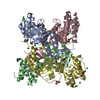
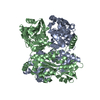
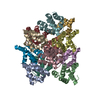
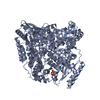
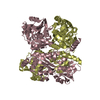
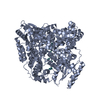


 PDBj
PDBj




